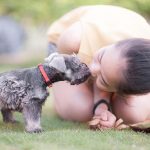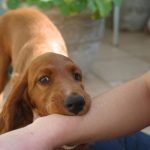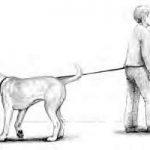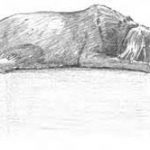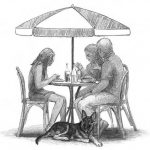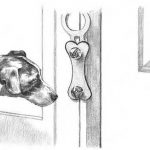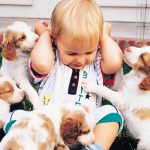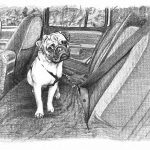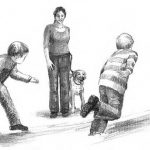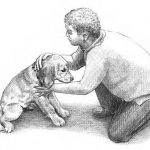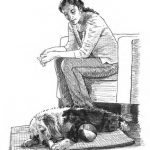- Previewing the stages of dog development
- Making sure that your puppy’s basic needs are met
- Communicating by using the language of a pup
- Establishing who’s in charge of the household
- Discovering how to train your puppy from his perspective
- Comparing hierarchy to democracy
The greatest gift you can give your dog is a stress-free existence. Structure your dog’s world so that he feels safe. Provide for his needs, anticipating them before he does, and incorporate as much playtime into your daily routine as you can. A young puppy doesn’t understand the word “no” or develop impulse control before he’s 6 to 8 months old, so put your expectations and frustrations on the back burner until you can channel both into useful communication. Puppyhood, like childhood, is short — let your puppy enjoy his to the fullest.
You have to understand the world from a dog’s perspective. Though his curiosity may result in behaviors that you find aggravating, don’t take any of his antics personally. Getting angry at a new dog is as silly and ineffective as yelling at a 6-month-old child. Not only will you not get through to him, but you’ll also frighten him. You, the very person he should feel most safe turning to, will be scaring and confusing him. This routine is neither educational nor good for long-term bonding. Look for a better way to navigate through this time — a much better way.
In this chapter, you put yourself in your dog’s paws and understand just how he views your world and life together.
Puppy
Because most adopted dogs are puppies, this chapter puts a lot of emphasis on puppies, but you’ll find useful information about older dogs as well.
Recognizing the Eight Stages of Dog Development
You may be dreaming of an agility champion, but setting your dog on course before she’s housetrained is like pressuring a toddler to balance your checkbook. As with children, your puppy’s mind will develop along a predictable course; you have to be patient. Knowing this fact helps you understand what to expect, what to teach your puppy, and what milestones will define your expectations and bolster your success.
Infancy (8 to 12 weeks)
Life for a young puppy centers on five basic needs: eating, drinking, sleeping, eliminating, and playing. Even though your puppy is capable of learning, don’t expect too much at this stage. You should be feeding your puppy three to four times a day, taking him out constantly, and letting him sleep when he wants to. Your puppy will learn best when you incorporate training into playtime. Show him the basic stuff: Hang out with him, use his name, talk to him, and introduce the leash. Discipline will only frighten your puppy and erode your relationship: He’s simply too young to comprehend it. Have fun and take lots of photos, because your puppy will be all grown up before you know it.
The terrible twos (12 to 16 weeks)
As your puppy matures, you’ll notice her personality developing. She’ll get a bit bolder and braver and harder to impress. By 12 weeks, a puppy’s brain is fully developed and she’s ready to learn. She’s old enough to understand and remember your direction, but she’s still too young to take matters into her own paws.
Remember
Puppies at this stage are starting to learn things, whether they’re guided or not. If you don’t train your puppy, she’ll train you.
The budding adolescent (16 to 24 weeks)
Suddenly, you may notice that a strange dog, who looks rather like your puppy did, is taking over your house. Welcome to adolescence. Be prepared and consider yourself warned: You’re about to enter the bratty zone. Try not to panic — as much as you may want to hide under the couch for the next three months, don’t! Now is the best time to start training. Because this stage lasts about eight weeks, break down lessons week by week. Breaking down lessons helps your puppy feel successful and allows him to master each exercise before you apply it in his day-to-day world. This concept is similar to letting children master the alphabet before expecting them to spell.
Puppy puberty (6 to 9 months)
Puppies at this stage go through a major transformation called growing up. You remember growing up, don’t you? With all its hormones, rebellion, confusion, and curiosity? Well, it’s never a pretty sight. On top of these typical growing pains is the awakening of breed-specific instincts that tell herders to herd, hunters to hunt, guarders to guard, and pullers to pull. This stage is utter canine chaos, and all while they’re still cutting their baby teeth! You now have this puppy/dog who’s full of hormones, high spirits, and anxiety. It’s no wonder she may give you the puppy equivalent of a teenage eye roll when you give her a command.
The trying teen (9 to 12 months)
Your first milestone is in front of you, but it’s not over yet. A puppy at this stage usually calms down and manages better on his own. He’ll chew his bone quietly, potty where he ought to, and listen most of the time. Okay, sometimes he’ll still ignore you. Puppies at this stage want to behave, but their teenage genes are relentlessly telling them to make one more glorious attempt for Top Dog status.
Warning!
This stage often brings with it a subtle campaign of defiance. You may not think a sloppy, sideways sit is a very big deal, but your dog makes a little mental check mark every time you let him get away with something. You can’t relax your efforts just yet!
The young adult (12 to 24 months)
At this age, your dog begins to hit her stride. If a dog isn’t spayed or neutered by now, this time is when the breeding age begins. The puppy personality is gone, replaced by a (hopefully) calmer manner and more stable, predictable personality.
Or not. About the time a pup reaches physical maturity is also when many owners first realize they’ve taken on more than they can handle and recognize that they ended up with a dog who’s too big, too active, or too dominant for them. Puppies grow up fast, and too many people put off until tomorrow the socializing and training they should have done yesterday. These birds now come home to roost. However, lots of these overgrown puppies just need a little work — some basic obedience and problem.
All young adults are bound to be a little more high spirited and distractible than a mature adult of 2 or more. These dogs still have a bit of growing up to do.
The adult dog (2 to 8 years)
This is it, the long stretch of time you will remember best when you reflect years hence. Dogs who mature into adulthood are in their prime years. If all has gone well, you have a nearly flawless dog here, calm and sensible, benefiting from that obedience training you instilled. Of course, you may also have a dog who’s settled into some bad habits. Of course, he couldn’t have gotten that from you, right?
The senior dog (8 years and older)
Depending on the breed, these years will be either a slow process of dignified deterioration or a rapid slide into old age. Of course it’s sad to see dogs age, as it’s sad to see humans age. Senior dogs are troopers, though. Older dogs are more docile and less destructive, and require less exercise than young ones. They are often wise and quiet, and can seem downright philosophical. A senior dog reminds you every day how loyal your friend has been for so long. Sure, she needs more loving care than ever, and health problems escalate, but you will be glad to give it in return for the affection you’ve received all this time.
Understanding Your Puppy’s Basic Needs
Puppy
Your puppy is a lot like a human baby. Okay, sure, your pup may have a furry coat, a curly tail, and a full set of teeth, but many of the differences stop there. Like a child, your puppy has basic needs and an instinct to satisfy them. A baby communicates his helpless neediness through crying. It’s a guardian’s role to interpret the cry and satisfy the need. In essence, a cry indicates that the baby lacks the ability to associate a specific need with a bodily sensation. When he’s hungry, his belly hurts. When he’s tired, his brain shuts down. When he’s thirsty, his throat constricts. If these needs aren’t satisfied, he gets anxious. When a loving caregiver routinely satisfies his needs, without stress, discipline, or confusion, he develops a strong bond with that person.
The same holds true for puppies. Like babies, they have five basic needs: eat, drink, sleep, potty, and play. Unlike babies, many puppies don’t cry when their needs aren’t met. Instead, they start nipping and, if directed, may bark and become frantic and fidgety. The behaviors are different, but the concept is the same. Both are easily overwhelmed when their bodies make demands. If initial nips are met with harsh discipline, the puppy may develop defense reactions, such as aggression or barking back.
Tip
You can help your puppy identify his needs by pairing directions with routines. Whereas a child develops language and a more civilized approach to communicating her requests, your puppy will develop his own system of communicating by prompting the routine. Read about puppy needs in the upcoming sections, and use Table 7-1 to create your own routines — your puppy will be ringing the bell to go outside in no time!
Remember
Whoever satisfies a need is held in high regard. Though it may take some time for your puppy to “pay you back” with his love and devotion, each passing day brings you closer to that ultimate connection. Need by need, your bond will grow.
Table 7-1 Needs Chart |
Your Puppy’s Need | The Word or Phrase You Say | The Routine You Follow |
Eating | “Hungry” or “Eat” | Schedule feeding times. Place the bowl in the same spot and encourage your puppy to sit before feeding. |
Drinking | “Water” | Keep the bowl in the same spot. Encourage him to sit before drinking. |
Going potty | “Outside,” “Papers,” “Go potty,” or “Get busy” | Encourage your puppy to nose/paw a bell to signal this need. Follow the same route to the same potty spot. Restrict attention until your puppy goes. |
Sleeping | “On your mat,” “In your crate,” or “Time for bed” | Designate one spot in each shared room. Take your pup to his mat or bed, provide a chew toy, and secure if necessary. |
Playing | “Bone,” “Ball,” “Toy,” or “Go play!” | Establish a play area inside and outside the house. Make sure all four paws are on the floor before you toss a toy or give a bone. |
Eating
Puppies are happiest when a predictable routine has been set. A hungry puppy is understandably upset and may show you by eating anything — even the difficult-to-digest things such as tissues, remote controls, or walls. Schedule feeding times and stick to them as closely as possible. If you notice your puppy getting nippy or difficult, check your watch. The behavior could be a result of hunger tension. See Table 7-2 for guidance when setting up feeding times.
Table 7-2 Your Puppy’s Feeding Schedule |
Age | Morning Meal (7 a.m.) | Midday Meal (11:30 a.m.) | Afternoon Meal (4 p.m.) | Late Evening Meal |
8 to 10 weeks | * | * | * | * |
10 weeks to 4 months | * | * | * | |
4 to 6 months | * | | * | |
A young puppy has a high metabolism and should have more frequent meals. Schedule three to four meals throughout the day, slowly phasing out meals as your puppy matures. At some point after your puppy reaches 6 months, you may drop to one meal.
Remember
Whoever feeds your puppy should follow the same organized routine that you do. Puppies (like kids) are happiest when they know exactly what will happen next.
Drinking
Puppies need a lot of water, especially when the weather is hot or when chewing and playing. Even though it’s important to allow them access to water when their system demands it, it’s equally important to monitor their drinking habits. Bladder muscles are the last to develop, so what goes in, comes out quickly. Dogs can hold their urine for a long time — puppies can’t.
Tip
Establish a drinking station for your puppy and keep her dish there whether it’s empty or full. Give your puppy water with her meals; after playing, chewing, or napping; or as you’re on your way to her potty area.
If you’re forgetful, it’s better to fill his dish and leave it out for her throughout the day. Though it may delay your housetraining, it’s better than having her go thirsty.
Tip
Restrict water after 7:30 p.m., unless you want to be up all night taking your puppy outside. If your puppy clearly needs a drink, either give her a small amount (no more than a cup for a large dog or a quarter cup for a small fry) or offer a couple ice cubes.
Sleeping
We all love a good sleep, and you’ll find that your puppy is no exception. Create a quiet space where your puppy can escape the daily hubbub and catch 40 winks whenever he needs too. Make it clear to friends and family that this area — perhaps a crate, bed, room, or pen — is off limits to people when your puppy needs to nap. An overtired puppy is impossible to deal with. Like a child, a puppy will simply melt down. In fact, when pushed, his mouthy, testy behavior may turn into snappy aggression. Don’t correct, worry, or admonish him. Have pity instead — he’s exhausted.
Tip
Like kids, some puppies have a hard time putting themselves to sleep, especially when excitement levels are high. If you have kids, ask them to baby him by staying quiet until he’s sleeping. Each time he seems tired, escort him to his resting area while saying a cue word like “Bed.” Eventually, he’ll go to this area on his own when he’s tired.
Going potty
Housetraining can’t be summed up any better than with the wonderful maxim, “Whatever goes in must come out.” Your puppy’s biological clock will have her eliminating on demand. When her bladder or bowels are pressed, she’ll let loose whether she’s outside or on the papers — or on the rug, if you’re not watching.
If your puppy is coming straight from Mom, she may have paved the way for you by urging her puppy to leave the “nest” when eliminating. This stage occurs between 7 and 8 weeks. If Mom was too relaxed or you picked up your puppy before this stage, the puppy will rely on you to clean up after her, a message of total care and devotion.
Your goals are to teach your puppy where to go and how to let you know if an obstacle (such as a door) is stopping her from getting there. Fortunately, you’ll find this task easy after you commit to a routine and relax your expectations. Tension or expressed frustration is confusing; your puppy won’t learn quickly and may grow increasingly afraid of you. Your puppy needs a schedule, a routine, and a consistent pattern — all of which are within your grasp.
Tip
For a lot more on housetraining, see Chapter Housetraining 101.
Playing
The urge to play and express himself energetically is one of the most natural responses in your puppy’s repertoire. As with children, play and lighthearted interactions can be fabulous instructional tools and can be used exclusively during your first few months together.
Remember
How you play with your young puppy determines your long-term relationship. Rough, confrontational games, such as wrestling or tug of war, communicate confrontation, which can be detrimental to your relationship. A confronted puppy will be more likely to challenge you and ignore your direction. Games such as the two-ball toss, soccer, and name games instill cooperation and a fun-loving attitude — this puppy won’t ever want to leave your side.
Speaking Doglish and Presenting Yourself As Top Dog
Dogs have a lot of team spirit. Many people refer to this as their pack instinct, but the concept of teams also works. Team consciousness and the canine psyche have a lot in common. Teams focus on winning, with each player working for it, wanting it, thinking about it, and striving for it. Dogs live their entire lives, every waking moment, by this same team structure. Instead of “winning,” however, their mantra is bonding and survival. To your dog, you and your family are her team.
Some other, less obvious factors also determine a team’s success: cooperation, structure, and mutual respect. Without these factors, even a group of phenomenal players would produce only chaos. A good team is organized so that all members know who’s in charge and what’s expected of each of them. And if one of them gets in trouble or gets hurt, that member can trust that another teammate will help out.
For your dog to feel secure and safe, she needs to know who’s in charge, and it’s your job to teach her what you expect. In dog land, teams are organized in a hierarchy, so you must teach your four-legged friend that two-legged team members are the ones in charge — the captains of the team. If you have more than one person in your household, teaching this concept requires some cooperation on everyone’s part, but it’s important if you want your puppy to mature into a dog who respects everybody.
Warning!
If you don’t organize the team hierarchy, your dog will, and that can be a real nightmare. If your dog has the personality to lead, you’ll find yourself living in a very expensive doghouse under dog rule. If your dog doesn’t have the personality to lead but feels like she has to because no one else is, you’ll end up with perhaps an even bigger headache, because dogs in this state are very hyper and confused.
So how do you organize your team and teach your dog the rules? You have to understand what motivates your dog’s behavior, and you have to master her communication skills. But you have one small problem: Your puppy doesn’t understand English. Like a human plopped into a foreign country where no one speaks her language, your puppy will feel lost in translation. To be the best teacher, you need to be fluent in Doglish, the language of dogs. Give your family or friends a lesson, too, and encourage consistency.
Doglish consists of three elements:
- Eye contact
- Body language
- Tone
In Doglish, words, feelings, and lengthy explanations don’t count. Complex reasoning in English is impossible for your puppy to follow. The following sections break down the three elements of Doglish so that you can put them into practice ASAP.
Remember
Figuring out Doglish may seem like hard work, but watching the techniques in action is quite fascinating. Your dog will respond to you more willingly if you make the effort to understand and use her language. With an ounce of effort, a little time, and some structure, you can earn your dog’s respect, cooperation, and trust. Plus, you’ll have a teammate who will be at your side when the cards are down. You can’t beat that bargain.
Eye contact: Attention = affirmation
Are you constantly making eye contact with your dog in stressful situations (someone’s at the door and he’s barking like a madman, or maybe he’s stealing the dishrag)? Are you having trouble encouraging your pup to pay attention to you? Well, guess what? By making constant eye contact, your dog thinks you’re depending on him to be the leader. He thinks you want him to make all the judgment calls. Before you can figure out how to handle these situations, you have to understand that, to train your dog, you must encourage him to look to you for direction.
Remember
When you make eye contact with your dog, you reinforce whatever behavior he’s actively engaged in. Look your well-behaved dog in the eye and guess what you get? You got it: a well-behaved dog. However, if you make eye contact while he’s running around the house with a wet wash rag flopping from his mouth, you’ll reinforce that behavior because you’re giving him the attention he so desperately wants. He wants you to look at him, so if you do so while he’s eating your favorite album, he learns to do that.
Think of your dog’s energy on a scale from 1 to 10, with 1 being sleep and 10 being hyperexcited play. Between 2 and 8 is the focused, civil, happy zone, which includes all the endearing behaviors you love, such as relaxing during a heartfelt pat, bringing a toy to you for play, and chewing on a bone while you’re busy. Between 8 and 10 is the impulsive, unfocused zone, which contains all the behaviors that drive you crazy. Some of these behaviors include jumping, stealing, nipping, and running out of control.
By realizing that dogs repeat behaviors that result in attention, you can see that you get what you interact with. By redirecting wild energy and focusing on the good stuff, you know what you get? A perfect little angel. (Well, almost.)
Tip
The bottom line is this: Make eye contact only when your dog is calm (in the 1–8 zone).
Believe it or not, the 8–10 zone is no picnic for your canine, either. Even though he’s rowdy and unfocused, this manic behavior is only a simple reaction to his misunderstanding of what you expect. Unfortunately, discipline doesn’t help this situation because your dog may interpret it as confrontational play. Structure, positive reinforcement, and training help the most. (See Chapters
Teaching Your Dog Manners and
Basic Training and Beyond for more on training.)
Body language: Stand up and stay calm
Body language is a funny thing. Imagine this: Your dog becomes excited and hyper when company arrives at the front door. Desperate to save face, you start shouting and pushing your dog as the company fends the two of you off with their coats. You try every possible command — “Sit, Boomer! Down! Off! Bad dog!” — but to no avail. The whole arrival scene is one big fiasco.
Remember
Body language is an integral part of Doglish. Play, tension, relaxation — they all have different postures. Your dog doesn’t quite grasp the “I’m pushing you frantically because I’m unhappy with your greeting manners” concept. By dealing with the situation in this way, you’re communicating differently than you think you are. In fact, by pushing and shouting, you’re actually copying her body language, which reinforces her behavior.
Tip
As you blaze the training trail, remember these guidelines:
– Stand upright and relax when directing your dog. When giving your puppy direction or a command, throw your shoulders back and stand tall like a peacock. Tell your family and friends about this peacock position, and start strutting your stuff.
– Don’t face off or chase your puppy when you’re mad. She’ll only think you’re playing.
– When you’re trying to quiet or direct your puppy, stay calm.
– Always remember that you set the example.
Remember
Can you ever get down and play or cuddle with your puppy or dog? Of course you can! Just don’t play with your puppy when she’s in a mischievous mood, or you’re asking for trouble.
Tone: Using the three D’s
If your dog thinks of you as another dog and you start yelling, he hears barking. Barking (yelling) interrupts behavior; it doesn’t instruct. It also increases excitement. You may have a puppy who backs off from a situation when you yell (although he’ll probably repeat the same behavior later). He’s backing off because your yelling frightens him, not because he understands what you’re yelling about. Yelling is just no good.
Remember
Commit three tones to memory — the three D’s:
– Delighted: Use this tone when you want to praise your dog. It should soothe him, not excite him. Find a tone that makes your pup feel warm and proud inside.
– Directive: Use this tone for your commands. It should be clear and authoritative, not harsh or sweet. Give your commands once from the Peacock Position.
If you bend over when giving your dog a command, don’t be surprised if he doesn’t listen. You’re doing the doggy equivalent of a play bow, which is a posture that invites a game. When giving your dog directions, stand tall and proud like a peacock.
– Discipline: You may not be much of a disciplinarian, but you should have a few tones that tell your dog to back off or move on. The word you use doesn’t matter as much as the tone. The tone should be shaming or disapproving, such as “How could you?” or “You’d better not touch that.” Discipline has to do with timing and tone.
Teaching kids how to use the proper toneIf you have kids, you’ve probably noticed that sometimes they call out to the puppy in a very high-pitched tone, and sometimes they don’t pronounce commands properly, either. Until kids are 12 years old, you’re better off focusing on what they’re doing right rather than homing in on their imperfections. Simply overenunciate all your commands so that the kids figure out how to pronounce them properly and in an appropriate tone. If you overenunciate each command, your kids will notice the effects and start mimicking you. And when your kids copy your intonations, they transfer the control from you to them. |
Tip
Don’t repeat your commands. Saying “Sit, sit, sit, Boomer, sit! Sit! Sit!” sounds different from “Sit” — which is what Boomer is used to. If you want your dog to listen when you give the first command, make sure that you give it only once; then reinforce your expectations by positioning your dog. (When positioning in a sit, remember to gently squeeze the waist muscles and lift up on your dog’s collar.)
Gimme, Gimme, Gimme: Puppies Want All the Attention
Puppy
Imagine being a puppy, with humans just being big dogs milling all about, jabbering away in some nonsensical language, and providing virtually no instruction on what to do. When you lay a head in their lap or paw at them inquisitively, the human may shoo you off or lay a warm hand on your head, while often continuing to ignore your request for direction. The talking box on the wall and hand-held objects hold more interest for the humans than your interaction does. You hear noise and more noise. You catch sniffs that can’t be explored or trailed. And you see sights that you’re expected to ignore. Being a puppy in a human’s world can be tough.
The power of positive attention
What do you do when you catch your puppy resting or chewing a bone quietly? “Nothing. It’s a moment of peace.” Well, it’s those times when you ought to be showering your puppy with attention. Not wild, twist-and-shout, hoot-and-holler attention, but calm, soothing, loving attention. A soft, whispering praise is best mixed with a massagelike pat.
Your dog will repeat whatever action you pay attention to.
Remember
Dogs are drawn to positive energy fields. Think of yourself as her teacher and mentor. If you keep up the cheer, your dog won’t want to be anywhere else.
Why negative attention doesn’t work
Picture a very excited, jumping dog. You’re trying to read the newspaper calmly, but he wants your attention. What do you think would happen if you tried to correct the dog by pushing him down and screaming “Off!”? In all likelihood, the dog would jump again. Do you know why? Because you just gave him attention. Attention, in a dog’s mind, includes anything from dramatic body contact to a simple glance. Yes, even looking at your dog reinforces his behavior.
Though this phenomenon may sound far fetched at first, it’s actually pretty elementary. Dogs think of you as another dog — really. Maybe a funny-looking dog with godlike powers, but a dog nonetheless. If they get excited and then you get excited, they think you’re following their lead. By mimicking their energy level, you communicate that they must interpret new situations. The fact that you’re upset with their behavior just doesn’t register. Being upset is a human emotion. Excitement and body contact is the dog way. Even if you push your dog so hard that he stops and slinks away, your only accomplishment is scaring him. And who wants to train a pup through fear? You have a better way.
Consider another example: What happens if your dog grabs a sock and everyone in the household stops to chase him? Think you have a dog party? You bet. The dog is thinking “What fun!” as he dives behind the couch and under the table. Chasing a dog doesn’t come across as discipline; it comes across as prize envy — “Whatever I have must be really good because everyone wants it!”
Remember
Dogs often interpret negative attention as confrontational play: “You’re animated, you’re loud, and you’re fierce. Let’s play rough!” Out-of-control negative attention reinforces the very behavior you’re trying to change. To resolve these problems, be patient and read on.
Showing Your Pup How to Live in a Human World
If this training isn’t coming naturally to you, don’t be discouraged. To be a schoolteacher for children, you’d have to enroll in four to six years of college education. However, to teach your puppy, you only need to understand the concepts and exercises outlined in this book.
Remember
A lot goes into being a good dog trainer, and most of it’s mental. Dogs, like humans, have spirits that you must understand and encourage in ways that make sense to the dog. Your dog has bestowed on you the highest honor, and it’s one you’d never receive from a human: a lifetime commitment to respect your judgment and abide by your rules. You need only show her how.
To show your dog how to respect you and your rules, remember three key points that a good dog trainer does:
- Accepts and modifies his own personality
- Never blames the pup
- Recognizes the pup’s unique personality
Recognize and modify your personality
Now’s the time to analyze yourself. Take out a pen and paper, and write down three adjectives to describe your personality. What kind of person are you? Demanding? Sweet? Forgiving? Compulsive? Be honest. Then compare your personality with your pup’s character.
Warning!
If you discover that you’re demanding, say, and your dog is sweet, someone’s going to have to change. Making too many demands on a sweet dog will only frighten him, and he’ll shut down or run away when training begins. If you’re compulsive and you have a laid-back dog, you’ll be laughed at. Have you ever seen a dog laugh at his owner? It’s quite embarrassing. For you to be a good dog trainer, you must modify your expectations to better suit your dog’s personality.
Never blame the pup
Believe it or not, puppies don’t react out of spite. Your puppy’s behavior is directly related to your own reactions, whether they’re positive or negative.
So how do you handle unruly situations? The first step is to stop blaming the dog.
Warning!
Never run at your puppy. Racing headlong toward a puppy is scary. Visualize someone two to four times your size barreling down on you. Talk about overwhelming. Your puppy may collapse in fear or run from you, but she won’t take anything useful from the situation. Consider other options, such as using treats to reinforce good behavior.
Recognize the pup’s unique personality
Yes, puppies have personalities, too. If you’ve had more than one pup in your lifetime, you know exactly what that means. Each dog is unique. And to train him, you must begin by understanding his personality.
Remember
No matter what his personality, your pup needs to interact and be understood. Dogs love to share their secret language with you, and they’re content staying close to you as long as you include them in your daily activities.
Regardless of size or coat color, your dog is hardwired to act like . . . well, like a dog. He isn’t a kitten, bunny, guinea pig, or child. His behavior is unique and predictable: He’ll walk on four legs, sleep at night, and seek affection. These universal behaviors can give you a leg up in communicating with and training him.
If dogs ran the worldOnly recently have people expected dogs to adjust to long periods of alone time. For most of the 20th century, no leash laws existed — hard to imagine, but true. Dogs were left out on the back porch during the day and often left to run free at night. Long ago, most dogs weren’t even considered pets. They were domesticated and bred to aid man in tasks that clearly advanced society, from herding sheep, to guarding property and towns, to hauling supplies in wagons or sleds. The evolution of dogs as “pets” has come with the expectation that they put their working genes to rest (which isn’t entirely possible), as well as a growing awareness of their psychological and emotional needs. Most dogs have retired from their genetic jobs. Dogs so completely identify with their group or team that few would even know how to cope if left on their own. Ask various breeds what they’d do if they were suddenly put out on the street, and although you may get different answers, none would much enjoy their independence: – Golden Retriever: Would scramble about for the nearest ball or stick and drop it eagerly at the nearest foot
– Border Collie: Would herd all the people within sight into a tight circle
– Beagle: Would sniff merrily through a crowd until someone started to follow
– Jack Russell: Would bark fanatically at a mysterious noise in the corner of a building until a crowd gathered
– Cavalier King Charles Spaniel: Would head for the nearest lap
– Labrador Retriever: Would race into the nearest restaurant, lie under the table, and wait eagerly for scraps to fall
|
Recognize your dog’s behavior patterns, understand his communication style, and adjust your approach to teaching him how to behave. You need to talk Doglish and look at your current situation from his point of view. This chapter also helps you get a handle on everyday life immediately, from civilizing your dog’s manners to deescalating mismanaged behaviors, such as hyperactivity, assertiveness, fear, and impulsivity.
Understanding How Hierarchy Differs from Democracy
Your dog looks to you and your family in much the same way she would seek inclusion in a group of dogs. She is a team player, as mentioned earlier. This truth places dogs, on a whole, above other species in their loyalty and focus for our direction. Defining her life’s orientation to your group activity, she focuses on her position within your family, yet she reflects her position in hierarchical terms, not as part of a democracy. This defining difference between our two species must be fully embraced. Democracy is an ineffective model when civilizing a dog.
Either be the team leader and give your dog direction, or she will — out of her desire to keep the family or pack system working — take over the leadership role and train you.
In a group, someone must take charge and make the important decisions.
It’s in their genes
Most people wouldn’t ignore a toddler who looked at them with a confused expression, but those same people may overlook a similar expression coming from their dog. Because dogs are genetically programmed, especially when young, to look for direction, the opportunity to capitalize on their devotion is in the human’s hands. When ignored, a dog often repeats whatever behavior got him attention previously, creating a hard-to-break cycle.
Tip
Teach your dog three directions that you can use whenever he looks to you for direction:
- Get your ball.
- Let’s find your bone!
- Sit/settle down.
If your dog hasn’t learned these directions, look carefully at the upcoming “Giving direction” section and then direct him to the object or into position. Praise his cooperation, even as you’re helping him respond appropriately.
Remember
When your dog stares at you, he is often looking for guidance, but constant adoration makes your dog restless. Acting out soon follows, often in the form of house-soiling, destructive chewing, or stealing objects.
If your puppy has been assertive from the get-go, he’s likely to have a more dominant, leadership-oriented personality. This puppy needs a consistent take-charge approach. If your dog develops these traits during adolescence or later, he has taken the leadership role only because you did not. You then need to change your behaviors to regain your status; although you need to be consistent, this dog will be grateful that you’re taking over the demanding job. Being a leader is hard work!
Asserting benevolent authority
If you suspect that your dog is organizing your routines, you need to reorganize the hierarchy. Unless you want to be dog trained, the first step in the process is deciding that you want to do it and reassuring yourself that you can do it. Attitude is everything.
Tip
Your dog is preprogrammed to accept direction, so in many ways, you’re already ahead of the game.
Defining your space
Dogs define their role based on social and spatial definition. If you walk around, step over, or move out of your dog’s way, your message is loud and clear: Your mindful avoidance communicates your respect for your dog’s authority. Stop right there and try the following exercises:
– Teach your dog “Excuse me.” Your dog identifies your relationship based on spatial deference: Either you move out of her way or she moves out of yours. Teach her to respect your space immediately. If she’s in your way, say, “Excuse me,” and nudge her gently with your foot until she moves. If she cuts in front of you, walk straight into her until she shifts out of your way. Is she leaning against you excessively or inappropriately? Say, “Excuse me,” and use your leg to push her off until she respects your personal space.
– Condition your dog to lie on the sidelines. Does your dog always position herself underfoot? Aside from being dangerous, her intrusion is a cry for attention. Provide her with a proper area in each room of your house and identify it with bedding and toys. If she’s reluctant to stay there, check out the upcoming “Assign play stations in each room” section.
The two preceding exercises are important lessons in civility, and even more essential if you’re living with a problem dog.
Warning!
If you ask your dog to move and she growls at you, stop. This action is a sign that it’s time to pick up the phone immediately and call for professional help. Actively aggressive behaviors require expertise that may go beyond the scope of this book — although you can read more about aggression in Chapter What Are Dogs and Why Do They Behave That Way? and Chapter Teaching Your Dog Manners
Remember
Encourage all your friends and family to take part in your efforts to civilize your dog. If your dog ignores any of them, step in to reinforce their directions. Your dog must learn to respect everyone.
Giving direction
Everyone knows that a small toddler needs lots of direction, interaction, and patience. Dogs do, too. The key difference is that children are programmed to communicate with words, whereas dogs are not, although they learn to respond to sound cues and hand signals. You need to teach your dog the proper response for a series of everyday directional cues. These six cues can get you and your dog started:
– Name: Help your dog create a positive association with his name. Call out your dog’s name whenever you come home or to highlight a positive moment, such as when you’re offering a treat, loving pats, or playtime with a favorite toy.
Warning!
Don’t call your dog for unpleasant activities, such as isolation or unwanted grooming. If you do, he may hear “Come” and think “Run!” If “Come” has a reverse effect, stop using it. Use a treat cup and also check out the other training techniques in Part IV. Of course, you could just keep your dog on leash.
Tip
Call your dog as you’re walking away from him or when you’re hidden from sight, to pique his interest. Shake a cup of treats while saying his name, to encourage his enthusiasm for listening and following you. Though initially he’ll respond for the food, you’ll eventually condition a positive cooperative habit. Ultimately, you can phase out food treats and replace them with praise and petting.
– Ball and/or toy: Often during the day, your dog may look to you for ideas. If you say nothing, his restlessness may lead to mischief. Instead, teach him these words. Each time you play with him or give him a chew, repeat a word like “Toy” or “Bone.”
– Sit/please: A dog who sits politely is, in essence, saying “Please.” Teach your dog to sit either by enticing him with a treat held near his nose and moved back over his head, or by placing pressure on his waist muscles with your thumb and forefinger as you put gentle upward pressure under his chin.
Tip
Teach your dog that he must sit before rewards, food, or attention.
– Wait/okay: This direction tells your dog to freeze and wait for your next cue. Use it at thresholds and curbs or when entering or exiting your home, a building, or your car. To teach it, either control your dog on a leash or hold him steady, pulling back as you say, “Wait”; then release him with “Okay.”
– Follow me: This direction simply reminds your dog that you’re the leader and will make all the directional decisions for both of you. More than a dominance gesture, your leadership efforts convey your willingness to be his guardian and protector.
– Settle down: This direction encourages your dog to relax. As often as possible, direct your dog to a mat or comfortable rug/bed and provide him with a displacement activity, such as a bone or toy, which will distract him and keep him from idly wandering about. You can use it both in your home or when traveling about. Whether your dog is restless at your dinner hour or quiet time, or you’re waiting your turn at the veterinarian, this familiar direction will give your dog a sense of calm.
Don’t be afraid to use a leashYou may be saying: “I want my dog to join me, but he’s so unmanageable. We try, but after a short bit, we have no choice but to shut him away by himself again. If he’d learn to behave, he’d get a lot more freedom.” If the thought of letting your dog loose leaves you shaking in your shoes, you’ve probably gotten yourself caught in a vicious cycle. You may not realize that, ironically, the prolonged periods of isolation are resulting in your dog’s impulsivity and mischief. One solution is to use your leash indoors. Find an appropriate training collar (see Chapter Basic Training and Beyond), and use a collar-and-leash ensemble to lead him through your home. Use the directions in this chapter to teach him his manners and socialize him to each room. The leash is not a cruel device; think of it as akin to holding a child’s hand. What’s cruel and confusing is forced isolation. When your dog is cooperating, let him drag the leash behind him so that you can easily grab it, if needed, for additional control. When you’re sure that his manners have improved and he’s acting civilly, you can dispense with the leash — but not before you’re certain that it’s no longer needed. |
Establishing your social status
Your dog is programmed to accept you and your family as if they were other dogs. She depends on the social structure you create to make her feel connected and safe. If you communicate direction to her and provide for her needs with consistency, she will look to you to interpret other situations as well. If your dog is unclear of what you want or you often get frustrated with her, she may perceive you as a moody adolescent dog rather than a leader. Even worse, your dog may decide that you’re an unreliable or incompetent leader, which is bound to make her insecure and frustrate her. When this happens, later behavior problems are virtually guaranteed.
Practice the exercises in the following sections to reestablish your social status.
Assign play stations in each room
Your home is nothing more than a big den to your dog. How you establish routines indoors affects your relationship more than any activities or training programs you’re involved in.
Tip
Think of providing your dog with a play station like offering a guest in your home a chair. Your dog doesn’t know where to go in your house until you tell him; when you do, he’ll feel welcome, calm, and included. If you don’t, he’ll likely misbehave, which provokes your negative attention. Because your negative reaction can be interpreted as a controlled or restrained confrontation, your dog may think his freedom is an invitation to play.
Give your dog a play station like this:
1. Decide the rooms your dog is welcome in.
If you have to isolate him now but want him to share, say, the whole house or the downstairs area, take strides immediately toward this goal.
2. Go into each room and select a spot on the floor (or a section of a chair/sofa) for your dog to call his own.
You may as well call this area a play station.
3. Identify that location with a rug, a flat mat, or bedding, and place a few of your dog’s favorite bones or toys on it.
4. Introduce your dog to his special area.
Bring him into the room on a leash if he’s too fidgety and say, “Settle down,” as you lead him to his play station. Sit with him and encourage him to focus on his things. Give him lots of attention and feed him treats.
Tip
Bring your dog with you to these places often. If he won’t stay at his play station, make sure that he’s had a good romp and time to potty, and then hold him still with a leash or secure a leash to something immovable.
Restraint at the door
From your dog’s perspective, your main door is the mouth of her den. Whoever orchestrates comings and goings runs the show. If your dog barges through or reacts inappropriately when visitors arrive, she’ll assume she’s in charge.
In essence, you may be paying the mortgage or rent on a very elaborate dog house. Changing this situation is easy enough, but to do so, consistency is a must:
1. Teach your dog to follow you in and out of the door.
Initially, manage her on a leash and teach her to properly respond to the directions “Wait” and then “Okay.”
2. Teach your dog a proper greeting ritual, remembering that good manners start at home.
Ignore your dog if she behaves in an overexcited or inappropriate manner when you or other family members arrive. If she has been confined alone in a crate, pen, or room, don’t speak to her until she has calmed down or is chewing on a toy. After she has calmed down considerably, brace her as you greet her (see Figure 7-1), with your thumb clipped over the underside of her collar to prevent her from jumping up.
Figure 7-1: Bracing a dog during greetings.
Create a greeting station 6–15 feet from the door. This location is the place where you’ll send your dog before opening the door when company arrives. Teach your dog the term “Go back” ahead of time, leading her to the area and telling her “Wait” while you open and shut the door.
Warning!
If your dog doesn’t stay put when no one is present, she won’t sit still when other people are. In this case, affix a leash to an immovable object. When you send her back from the door, secure her on the leash. Practice doing this routine when no one is there, and then with your family, and each time someone calls. Release your dog after you’ve welcomed the visitor, but only when she has calmed down.
Remember
The goal is for your dog to mirror and mimic your response to newcomers. Your dog isn’t the leader — you are. You can shape her responses by establishing your authority in this way.
Was that out of spite?Do you think your dog behaves poorly out of spite? Think again. Dogs repeat behavior that get them attention (good or bad) and often act out of anxiety when left alone, but they don’t react out of spite. Dogs aren’t dishonest or mean. The conclusion that your dog is vengeful will do nothing for your relationship — such thoughts only result in bad energy in the home. Ask not what your dog is doing wrong, but what you may not be doing right. |
by Eve Adamson, Richard G. Beauchamp, Margaret H. Bonham, Stanley Coren, Miriam Fields-Babineau, Sarah Hodgson, Connie Isbell, Susan McCullough, Gina Spadafori, Jack and Wendy Volhard, Chris Walkowicz, M. Christine Zink, DVM, PhD





